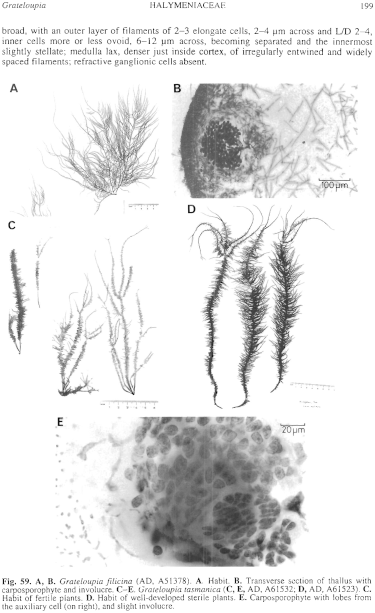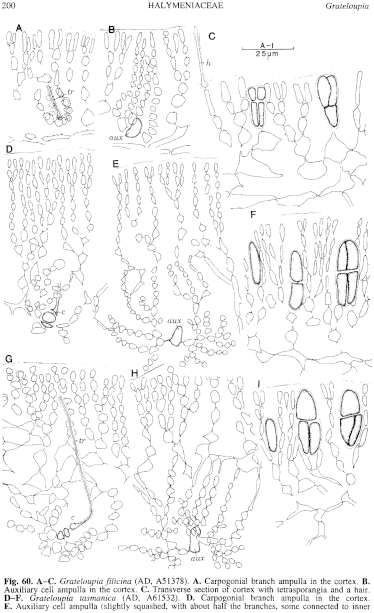|
|
|
|
|
|||||||||||
|
Electronic Flora of South Australia Species Fact Sheet
Phylum Rhodophyta – Class Florideophyceae – Order Gigartinales – Family Halymeniaceae
Thallus (Fig. 59C, D) medium to dark red-brown to yellow-brown, 10–30 cm high, cartilaginous and only slightly adherent to paper, with percurrent compressed axes either with margins and faces covered with short, fusiform ramuli or bearing elongate, tapering laterals covered with such ramuli; axes (1–) 2–4 mm broad, 0.5–1 mm thick, laterals 2–7 cm long, 0.5–1 mm broad, ramuli (0.5–) 1–2 (–3) cm long, 0.5–1 mm broad, tapering. Holdfast discoid, 1–4 mm across, with several crowded axes; epilithic. Structure (Figs 59E, 60D) of a cortex 40–180 µm and 8–20 cells thick, outer cortex of branched anticlinal filaments 4–7 cells long with the outer 3–4 cells isodiametric to slightly elongate in section, 2–3 (–4) µm in diameter, inner cortical cells ovoid to angular, becoming separated and slightly stellate. Medulla of sparse irregular filaments with thick sheaths, refractive ganglionic cells absent.
Reproduction: Sexual thalli probably dioecious. Carpogonial branch ampullae (Fig. 60D) arising in inner cortex, with 3–4 short secondary and occasional tertiary filaments of sub-spherical cells, and a 2-celled carpogonial branch. Auxiliary cell ampullae (Fig. 60E) in inner cortex, much branched but not converging above, with 4–6 secondary filaments each with short tertiary filaments of small cells, the end cells often pit-connected to cortical cells. Carposporophyte (Fig. 59E) ovoid with the basal elongate auxiliary cell having two lateral connections to bushy ampullary filaments which cut off further short chains of small ovoid cells around the base of the carposporophyte; all except the basal cells of the carposporophyte become ovoid to angular carposporangia, 6–10 µm across; involucre prominent, derived largely from medullary filaments, with a small ostiole. Spermatangia not observed.
Tetrasporangia (Fig. 60F) scattered in the cortex of the small ramuli or near the apices of laterals, occasionally on the axes, arising from mid cortical cells at the base of the anticlinal filaments, elongate ovoid, 25–35 µm long and 8–12 µm in diameter, cruciately divided.
Type from Taroona, Tas., low eulittoral (Sanderson, 24.xi.1991); holotype and isotype in AD, A61532.
Selected specimens: Musselroe Bay, Tas., on rocks at low tide (Perrin, 1.vi.1940; AD, A8499) and drift (Perrin, March 1950; AD, A16411 and A49725; BM). Coles Bay, Tas., 0–1 m deep (Kraft, 16.xii.1992; MELU, A40488). Swansea, Tas., low intertidal (Kraft, 15.xii.1992; MELU, A40451). Orford, Tas. (Meredith; MEL, 502374). Eaglehawk Neck, Tas., on intertidal boulders (Kraft, 26.ii.1983; MELU, A37995–38000). Kangaroo Point, Derwent R., Tas. (Gulliver, Dec., 1871; MEL, 668721, 668722). Adventure Bay, Bruny I., Tas. (Perrin, 16–20.ix.1948; AD, A49726). Kingston, Tas., low eulittoral (Sanderson, 24.xi.1991; AD, A61523). Taroona, Tas., upper sublittoral (Wollaston & Mitchell, 28.ii.1964; AD, A27935).
Distribution: Eastern Tasmania.
Taxonomic notes: In habit, Grateloupia tasmanica is most similar to forms of G. filicina which bear short lateral branches, but it differs from the latter in being more robust and cartilaginous, in the abundance of timiform ramuli, and in the more elaborate auxiliary cell ampullae with a well developed involucre.
The first description of Grateloupia prolifera by J. Agardh (1876, p. 150) included specimens of Meredith from Tasmania (from Orford, e.g. LD, 22596) and of Travers from the Chatham Is. J. Agardh's description (especially 1879, p. 111, pl. 7 figs 1–8) of reproductive stages was based on the Chatham Is specimens and Chapman & Parkinson (1974, p. 242) selected one of these (LD, 22594) as lectotype of G. prolifera, which they placed as a synonym of G. prolongata J. Agardh (1848, p. 10).
The Tasmanian and Chatham Is plants are clearly different, as Chapman & Parkinson (1974, p. 243) realised, and the Tasmanian taxon is here described as a new species. It is only known from the east coast of Tasmania, near low tide level on coasts of moderate wave action.
References:
AGARDH, J.G. (1848). Nya alger från Mexico. Öfvers. K. Svenska Vetensk. Akad. Förh. 4(1), 5–17.
AGARDH, J.G. (1876). Species Genera et Ordines Algarum. Vol. 3, Part 1 - Epicrisis systematis Floridearum, pp. i-vii, 1–724. (Weigel: Leipzig.)
CHAPMAN, V.J. & PARKINSON, P.G. (1974). The marine algae of New Zealand. Part DI: Rhodophyceae. Issue 3: Cryptonemiales. (Cramer: Germany.)
The Marine Benthic Flora of Southern Australia Part IIIA complete list of references.
Publication:
Womersley, H.B.S. (14 January, 1994)
The Marine Benthic Flora of Southern Australia
Rhodophyta. Part IIIA, Bangiophyceae and Florideophyceae (to Gigartinales)
Reproduced with permission from The Marine Benthic Flora of Southern Australia Part IIIA 1994, by H.B.S. Womersley. Australian Biological Resources Study, Canberra. Copyright Commonwealth of Australia.
Illustrations in Womersley Part IIIA, 1994: FIGS 59 C–E, 60 D–F.

Figure 59 enlarge
Fig. 59. A, B. Grateloupia filicina (AD, A51378). A. Habit. B. Transverse section of thallus with carposporophyte and involucre. C–E. Grateloupia tasmanica (C, E, AD, A61532; D, AD, A61523). C. Habit of fertile plants. D. Habit of well-developed sterile plants. E. Carposporophyte with lobes from the auxiliary cell (on right), and slight involucre.

Figure 60 enlarge
Fig. 60. A–C. Grateloupia filicina (AD, A51378). A. Carpogonial branch ampulla in the cortex. B. Auxiliary cell ampulla in the cortex. C. Transverse section of cortex with tetrasporangia and a hair. D–F. Grateloupia tasmanica (AD, A61532). D. Carpogonial branch ampulla in the cortex. E. Auxiliary cell ampulla (slightly squashed, with about half the branches, some connected to inner cortical cells). F. Transverse section of cortex with tetrasporangia. G–I. Grateloupia intestinalis (AD, A61524). G. Carpogonial branch ampulla in the cortex. H. Auxiliary cell ampulla, with filaments connected to inner cortical cells. I. Transverse section of cortex with tetrasporangia.

|
Email Contact: State Herbarium of South Australia |

|